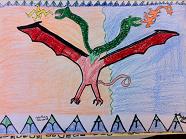 |
 |
 |
 |
Grades/Level: Lower Elementary (K–2)
Subjects: Visual Arts, English–Language Arts
Time Required: 2–Part Lesson
Two class periods
Author: Antoinette Pippin, Elementary School Teacher
Dr. Theodore T. Alexander Science Center, Los Angeles Unified School District
Permissions: 
The lesson plan and downloadable materials on this page are licensed under a Creative Commons Attribution 4.0 International License. |
 |
|
 |
 |
 |
 |
 |
 |
 |
Lesson Overview |
 |
|
 |
Students are introduced to the mythological creatures featured in the myth of Hercules (Roman name for the Greek hero Herakles). They learn new vocabulary related to the creatures' body parts (e.g., talons, hooves, etc.), and plan and create a drawing of an original mythological creature. Students then name their creature and write a descriptive sentence about it.
|
 |
 |
 |
 |
 |
Learning Objectives |
 |
 |
Students will be able to:
• plan an original mythological creature using animal attributes in a novel way.
• create a drawing of an original mythological creature.
• acquire a vocabulary of animal attributes.
• write a descriptive sentence about their mythological creature.
|
 |
 |
 |
 |
 |
 |
 |
 |
Materials |
 |
• Reproduction of The Lansdowne Herakles by an unknown Roman
• Reproduction of Water Jar attributed to the Eagle Painter
• Teacher Resource: "The Twelve Labors of Herakles"
• Strong Stuff: Herakles and His Labors, book by John Harris (optional)
• Pencils
• Student Handout: "Circle Map®"
• Student Handout: "Animal Attributes"
• Student Handout: "Creature Planning Sheet"
• Colored pencils, markers, and/or crayons
• Student Handout: "Student Worksheet"
|
 |
 |
 |
 |
 |
|
|
 |
 |
 |
 |
 |
Lesson Steps |
 |
1. Show and introduce the reproductions of The Lansdowne Herakles and Water Jar to the class.
2. Then, referring to the teacher resource "The Twelve Labors of Herakles" or another resource, describe the twelve labors of Herakles to the students. Discuss the mythological creatures depicted in the story and in the artworks (e.g., the Nemean Lion and the Lernean Hydra). Tell the students that mythological creatures are animals of fantasy. They do not exist in reality. Usually, they are a mixture of several different real animals. Tell them that they will be creating their own mythological creature.
3. Briefly talk about and name the different parts of the human body with the class. Then pass out pencils and the "Circle Map®" student handout. Ask students to draw different animal body parts in the circle map (for examples of circle maps, download Thinking Maps® [PDF, 409KB])
4. Have students pair-share about what they know about animal bodies. Depending on the level and age of your class, you might give students a sentence starter like "Some animals have...."
5. Pass out the student handout "Animal Attributes" and explain the different words (e.g., talons, scales) with which students may not be familiar.
6. Ask the students to discuss with their partners which animal attributes they want to use for their mythological creature's body. Let them know that, just like the Lernean Hydra depicted on the Water Jar and in the myth of Herakles, their creature may have multiple appendages (limbs or parts). Remind students that they will be creating a new creature, so it should not be exactly the same as the ones they have studied.
7. After students have discussed their creature's body, pass out the "Creature Planning Sheet" student handout. Tell each student to use this to make a plan for their own mythological creature. You may want to model how to complete this planning sheet, which includes drawings and words. Have students refer to the "Animal Attributes" handout as they plan their creature. Tell them that there are two empty boxes on the planning sheet to use for drawing extra or different parts that they imagine.
8. After students have finished their plans, lead a class discussion about their ideas.
9. Then give students a moment to add to or elaborate their plan.
10. Pass out the colored pencils, markers, and/or crayons, as well as the "Student Worksheet" handout. Now tell students to create a complete drawing of their creature on this worksheet. Depending on the age and level of your students, you may want to model how to use the planning sheet as a reference for drawing their creature on the "Student Worksheet."
11. After students have completed their drawing, tell them to name their mythological creature and write a descriptive sentence that describes it on the "Student Worksheet."
12. Display all the students' drawings in the classroom and have a "gallery walk." Lead a discussion about each student's mythological creature. You may do compare-and-contrast activities or sorting activities with the creatures according to their attributes.
|
 |
 |
 |
| Water Jar, attributed to the Eagle Painter, about 525 B.C.
|
 |
|
 |
 |
 |
 |
 |
 |
 |
Assessment |
 |
Students will be assessed on their:
• plan for an original mythological creature that uses animal attributes in a
novel way.
• drawing of their original mythological creature based on their plan.
• use of vocabulary of animal attributes.
• descriptive sentence about their mythological creature.
|
 |
 |
 |
 |
 |
Extensions |
 |
Have your students write a half-page story or myth about the creature they planned and created.
|
 |
 |
 |
 |
 |
 |
 |
 |
 |
Standards Addressed |
 |
Visual Arts Content Standards for California Public Schools
Grade 1
2.0 Creative Expression
2.4 Plan and use variations in line, shape/form, color, and texture to communicate ideas or feelings in works of art.
English–Language Arts Content Standards for California Public Schools
Grade 1
Writing
1.0 Writing Strategies
1.1 Select a focus when writing.
1.2 Use descriptive words when writing.
1.3 Print legibly and space letters, words, and sentences appropriately.
|
 |
|
 |
 |
 |






